模拟式控制器(精选)
- 格式:ppt
- 大小:4.17 MB
- 文档页数:82
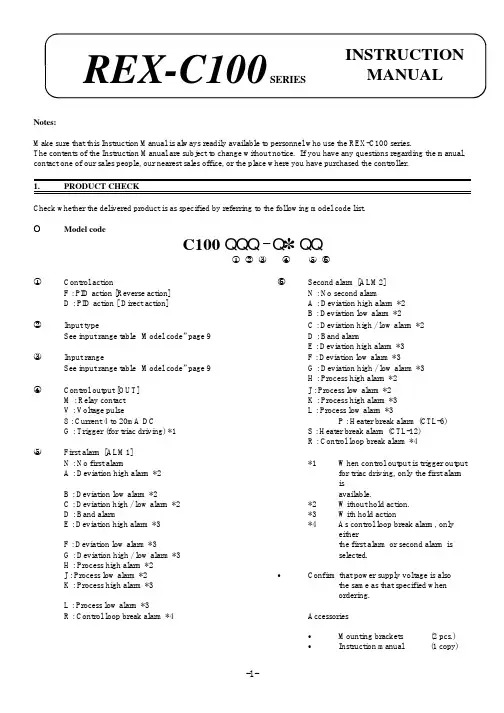
Notes:Make sure that this Instruction Manual is always readily available to personnel who use the REX-C100 series.The contents of the Instruction Manual are subject to change without notice. If you have any questions regarding the manual,contact one of our sales people, our nearest sales office, or the place where you have purchased the controller.1.PRODUCT CHECKCheck whether the delivered product is as specified by referring to the following model code list.OModel codeC100 QQQ - Q ~ QQÎ Ï Ð Ñ Ò ÓÎControl actionÓSecond alarm [ALM2]F : PID action [Reverse action]N : No second alarmD : PID action [ Direct action]A : Deviation high alarm *2B : Deviation low alarm *2ÏInput typeC : Deviation high / low alarm *2See input range table “Model code” page 9D : Band alarmE : Deviation high alarm *3ÐInput rangeF : Deviation low alarm *3See input range table “Model code” page 9G : Deviation high / low alarm *3H : Process high alarm *2ÑControl output [OUT]J : Process low alarm *2M : Relay contact K : Process high alarm *3V : Voltage pulseL : Process low alarm *38 : Current 4 to 20mA DCP : Heater break alarm (CTL-6)G : Trigger (for triac driving) *1S : Heater break alarm (CTL-12)R : Control loop break alarm *4ÒFirst alarm [ALM1]N : No first alarm*1When control output is trigger output A : Deviation high alarm *2for triac driving, only the first alarm isB : Deviation low alarm *2available.C : Deviation high / low alarm *2*2Without hold action.D : Band alarm*3With hold actionE : Deviation high alarm *3*4As control loop break alarm, only eitherF : Deviation low alarm *3the first alarm or second alarm is G : Deviation high / low alarm *3selected.H : Process high alarm *2J : Process low alarm *2CConfirm that power supply voltage is alsoK : Process high alarm *3the same as that specified when ordering.L : Process low alarm *3R : Control loop break alarm *4Accessories C Mounting brackets (2 pcs.)CInstruction manual(1 copy)REX-C100SERIESINSTRUCTION MANUALFig. 1Fig. 22.MOUNTING •DimensionsUnit : mm (inch)* Dimensions in inches are shown for reference•Mounting proceduresThickness of panel board:1 to 5mm or 5 to 9mm (0.04 to 0.20 inch or 0.20 to 0.35 inch)uWhen the controllers are mounted on panel with 1 to 5mm in thickness ÎMake a rectangular cutout corresponding to thenumber of controllers to be mounted on panel by referring to the panel cutout dimensions.ÏSince the mounting brackets are already installed onthe controller, insert the controller into the panel from the panel front without removal of the brackets (Fig. 1).uWhen the controllers are mounted on panel with 5 to 9m in thickness ÎRemove the mounting brackets from the controllerwith a slotted screwdriver.ÏEngage each mounting bracket with holes markedwith “5.9" on the housing (Fig. 2) and then insert the controller into the panel from the panel front.OCautions for mountingMo untingbracketAvoid the following location where the controller is mounted.C Location where ambient temperature is more than 50E C (122E F) or less than 0E C (32E F).C Location where humidity is high.C Location where corrosive gas is generated.C Location where strong vibration and shock exist.C Location where flooding and oil splash exist.C Location where much dust exists.CLocation where inductive disturbance is large and otherlocation where bad influence is exerted on electric instrument.3.WIRING•Rear terminalsNotes1.Terminals which are not used according to the controller type are all removed.2.For thermocouple input, no metal piece is attached to terminal No. 10. Instead, the temperature compensationelement in the internal assembly is projected through a hole at terminal No. 10.Do not damage the above temperature compensation element when the internal assembly is removed from the case.O Cautions for wiring(1)Conduct input signal wiring away from instrument, electric(3)For wiring, use wires conforming to domesticequipment power and load lines as such as possible to avoid standard of each country.noise induction.(4)About 5 to 6 sec. are required as the(2)Conduct instrument power wiring so as not to be influenced preparation time of contact output duringby noise from the electric equipment power.power ON. Use a delay relay whenthe outputIf it is assumed that a noise generation source is located near line, is used for an external interlock circuit.the controller and the controller is influenced by noise, use anoise filter (select the filter by checking instrument power(5)The figures below show the REX-C100 circuit supply voltage.)configuration. When connecting wires, notethat the power, input, MCU and output circuitsC Sufficient effect may not be obtained depending on the are isolated independently, while the inside offilter. Therefore, select the filter by referring to its the input and outputcircuits are not isolated.frequency characteristic, etc.ÎFor instrument power wiring, if it is assumed that noiseexerts a bad influence upon the controller, shorten thedistance between twisted power supply wire pitches.(The shorter the distance between the pitches, the moreeffective for noise reduction).ÏInstall the noise filter on the panel which is alwaysgrounded and minimize the wiring distance between thenoise filter output side and the controller power terminals.Otherwise, the longer the distance between output sideand instrument power terminals, the less effective for REX-C100 circuit configurationnoise.ÐDo not install fuses and / or switches on the filter outputsignal since this may lessen filter effect.WIRING AND NAME OF PARTS•Wiring exampleREX-C100F GG-M*-~2N-HA OF PARTSÑSet-value increment keyC Used when the number needs to be increasedfor set-value change.ÒMeasured-value (PV) display unit [Green]C Displays measured-value (PV)C Displays a parameter symbol in the parametersetting mode.ÓSet-value (SV) display unit [Orange]C Displays set-value (SV)C Displays set-value corresponding to theparameter symbol displayed on the measured-value (PV) display unit.ÎSet (SET) keyC The set-value thus changed is enteredÔControl output (OUT) lamp [Green]C Parameters in the parameter setting mode are C Lights up when the control output is turnedON.selected in due order.C Can select PV / SV display mode, SV settingÕAuto-tuning (AT) lamp [Green]mode, and parameter setting modes.C Flashes during auto-tuning.ÏSetting digit shift keyÖFirst alarm (ALM1) lamp [Red]C Used when the cursor (brightly lit) is moved to C Lights up when the first alarm is turned ON.the digit whose number needs to be changed for C When a control loop break alarm (LBA) is set-value change.selected as the first alarm, this lamp lights up.ÐSet-value decrement key×Second alarm (ALM2) lamp [Red]C Used when the number needs to be decreased C Lights up when second alarm is turned ON.for set-value change.C When either a heater break alarm (HBA) orcontrol loop break alarm (LBA) is selected asthe second alarm, this lamp lights up.5.OPERATION•Calling-up procedure of each mode:Press the key.Input type code / input range displayThis controller, with the power turned ON, displaysautomatically the input type code on the measured-value (PV)display unit and the input range, on the set-value (SV) displayunit, respectively.Example : For a controller with the K thermocouple inputtype and input range from 0 to 1372E C.ÎDisplays the input type code.: Indicates input abbreviation.unit. ( : E F)input type code table).ÏDisplays the input range.< Input type code >Code Input Type Code Input typeRSBW5Re/W26RePLIIPt100JPt100PV / SV display modeC Displays measured-value (PV) on the measured-value(PV) display unit and set-value (SV) on the set-value (SV)display unit. Usually the control is set to this modeexcepting that the set-value (SV) and/or the parameter set-value are changed.PV / SV display modeC Pressing the key lights the least significant digit onvalue (SV).In order to register the value whose setting was changed,always press the key after the value is changed.sec. in the PV / SV display or SV setting mode, thecontroller is set to the parameter setting mode.C Parameters in the parameter setting mode changes in dueorder every time the key is pressed (See page 6).and keys are pressed.C In order to register the value whose setting was changed,press the key after change to shift to the nextsec.•When no key is operated for more than 1 minute.•Parameter typesThe following parameter symbols are displayed one by one every time the key is pressed.Current transformer input (CT)Setting is not possible.Set heater break alarm value byreferring to this value.Display input value from thecurrent transformerCTSecond alarm Set alarm set-value of second alarm.AL2Control loopbreak alarm (LBA)0.0 to 200.0 min.Set control loop break alarmset-value.Cannot be set to “0.0".8.0LbAAuto-tuning (AT)0 : Auto-tuning end or stop1 : Auto-tuning startTurns the auto-tuningON/OFF.ATUIntegral time (I)1 to 3600 sec.Eliminates offset occurringcontrol is performed. I actionturns OFF with I set to “0".240IAnti-reset windup (ARW)1 to 100% of proportional band.Prevents overshoot and/orundershoot caused by integralaction. I action turns OFFwith this action set to “0".100ArSet data lock 0100 : No set data locked (Allparameters changeable)0101 : Set data locked (All parametersnot changeable)0110 : Only the set-value (SV) ischangeable with the set data locked.Performs set data changeenable / disable.0100LCK* The second alarm (or first alarm), heater break alarm, control loop break alarm parameter symbols are not simultaneously displayed. * Heater break alarm is not available on a current output.C Parameter setting procedure Setting set-value (SV)Following is an example of setting the set-value (SV) to 200E C. (PV : 30E C)Î Set to the set modeÏ Shift of the digit brightly litÐ Set-value increase or decrease ÑSet-value entryPress the key to Press the key to shift Press the key to set “2".After finishing the setting,enter the SV setting mode.the digit which lights brightlypress thekey. All ofController returns to the PV/SV display mode.Example : When a temperature of 199E C is changed to 200E C.Set-value increase or decreasePress the key to shift the digit brightly lit to the least significant digit. Press the key to change “9" to “0", therebyobtaining 200E C. The same applies to set-value decrease.Example : For changing 200 to -100.Minus (-) value settingPress the key to shift the digit brightly lit to the hundreds digit. Press the key to decrement figures in order of÷ 0 ÷ -1.Setting parameters other than set-value In the PV/SV display modeIn the parameter setting modeKey operational cautions CFor this controller, the value whose setting was changed is not registered. It is registered for the first time it is shifted to the next parameter by pressing the key.setting mode, set data lock is activated.In this case, change the “” parameter set-value to “0100".the parameter setting mode.Press thekey by the required number of times untilkey after the setting is finished in the parameters).When no parameter setting is required, return the controller to the PV/SV display mode.¬Pay attention to the following when the parameters described below are set.Auto-tuning (AT)C Prior to starting the auto-tuning function, end all the parameter settings other than PID and control loop break alarm(LBA).Heater break alarm (HBA)C Set heater break alarm set-value to a value about 85% current transformer input value. However, when power supplyvariations are large, set the alarm to a slightly smaller value.In addition, when two or more heaters are connected in parallel, set the alarm to a slightly larger value so that it is activated even with only one heater is broken. (However, within the value of a current transformer input value).C When the heater break alarm set-value is set to “0.0" or the current transformer is not connected, the heater breakalarm is turned ON.Control loop break alarm (LBA)C Usually set the set-value of the LBA to a value twice the integral time (I).O Set data locking procedureThis controller is provided with a set data locking function which disables each set-value change by the front key and also the auto-tuning function. Use this function for malfunction prevention at the end of each setting.C Press the key by the required number of(PV) display unit.C Press the , and keys to set the•Display at error occurrence< Heater break alarm >Display CauseMeasure(Lights)C Controlled object trouble (No power supply,incorrect wiring, etc).C Sensor trouble (Sensor disconnected, shorted, etc).C Actuator trouble (Weld relay contact, incorrectwiring, relay contact not closed, etc).C Output circuit trouble (Weld internal relay contact,relay contact not opened or closed, etc).C Input circuit trouble (The measured-value does notchange even if input changes, etc).Control system check(Error cause cannot bespecified)Check whether there is no effectby disturbances (Other heatsource, etc).LBA set time check< Overscale, Underscale >Input type Input display rangeTCK-30 to +1372E C -30 to +2502E F J-30 to +1200E C -30 to +2192E F R, S-30 to +1769E C -30 to +3216E F B-30 to +1820E C -30 to +3308E F E-30 to +1000E C -30 to +1832E F T-199.9 to +400.0E C -199.9 to +752.0E F N-30 to +1300E C -30 to +2372E F PLII-30 to +1390E C -30 to +2534E F L-30 to +800E C -30 to +1600E F U-199.9 to +600.0E C -199.9 to +999.9E F W5Re/W26Re-30 to +2320E C -30 to +4000E FRTDPt100JPT100-199.9 to +649.0E C Pt100-199.9 to +999.9E F。
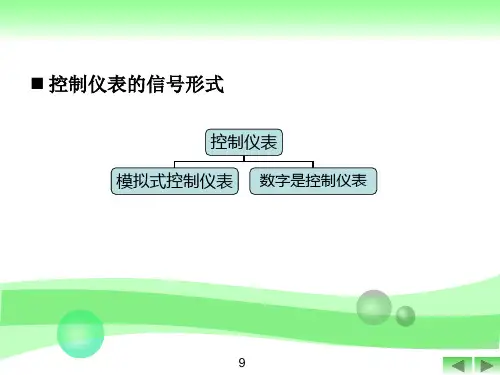
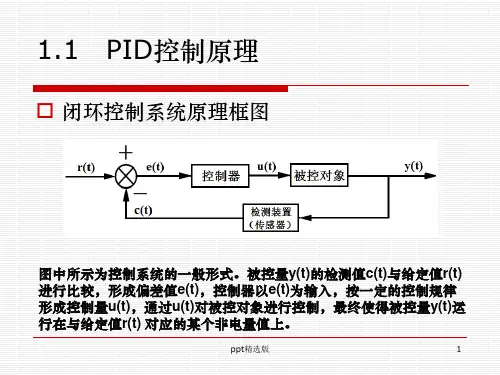
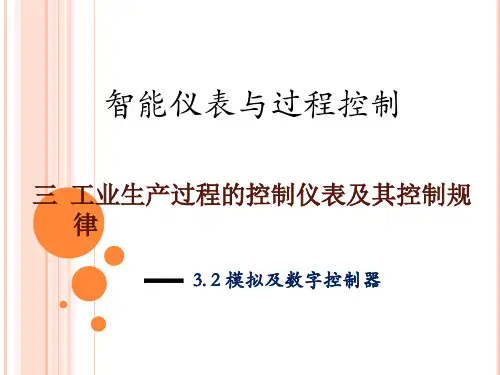
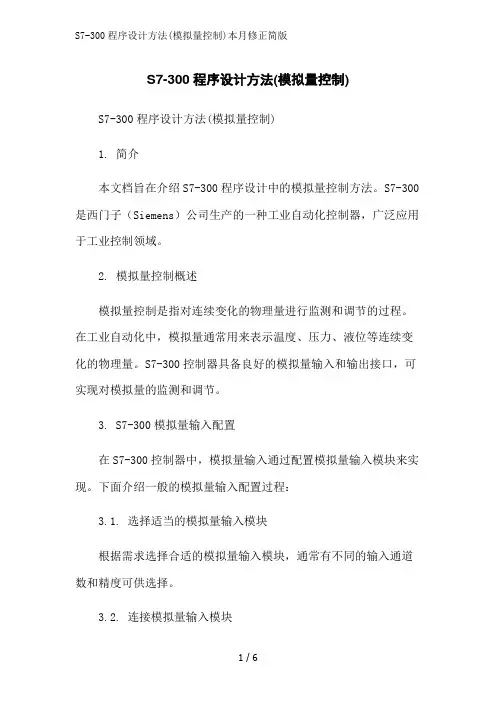
S7-300程序设计方法(模拟量控制)S7-300程序设计方法(模拟量控制)1. 简介本文档旨在介绍S7-300程序设计中的模拟量控制方法。
S7-300是西门子(Siemens)公司生产的一种工业自动化控制器,广泛应用于工业控制领域。
2. 模拟量控制概述模拟量控制是指对连续变化的物理量进行监测和调节的过程。
在工业自动化中,模拟量通常用来表示温度、压力、液位等连续变化的物理量。
S7-300控制器具备良好的模拟量输入和输出接口,可实现对模拟量的监测和调节。
3. S7-300模拟量输入配置在S7-300控制器中,模拟量输入通过配置模拟量输入模块来实现。
下面介绍一般的模拟量输入配置过程:3.1. 选择适当的模拟量输入模块根据需求选择合适的模拟量输入模块,通常有不同的输入通道数和精度可供选择。
3.2. 连接模拟量输入模块将模拟量输入模块与控制器连接。
通常采用总线或直接连接方式。
3.3. 配置模拟量输入模块在S7-300控制器的编程软件中,进行模拟量输入模块的参数配置。
包括输入通道数、量程范围、采样周期等。
3.4. 读取模拟量输入数值在PLC程序中,通过相应的指令读取模拟量输入模块的数值。
可以根据需要进行处理和判断,进一步实现对模拟量的监测和控制。
4. S7-300模拟量输出配置S7-300控制器不仅支持模拟量输入,还支持模拟量输出。
下面介绍一般的模拟量输出配置过程:4.1. 选择适当的模拟量输出模块根据需求选择合适的模拟量输出模块,通常有不同的输出通道数和分辨率可供选择。
4.2. 连接模拟量输出模块将模拟量输出模块与控制器连接。
通常采用总线或直接连接方式,需要注意与输入模块的通道对应。
4.3. 配置模拟量输出模块在S7-300控制器的编程软件中,进行模拟量输出模块的参数配置。
包括输出通道数、输出范围、初始值等。
4.4. 写入模拟量输出数值在PLC程序中,通过相应的指令将需要的模拟量输出数值写入输出模块。
可以根据需要实现对模拟量的精确控制。
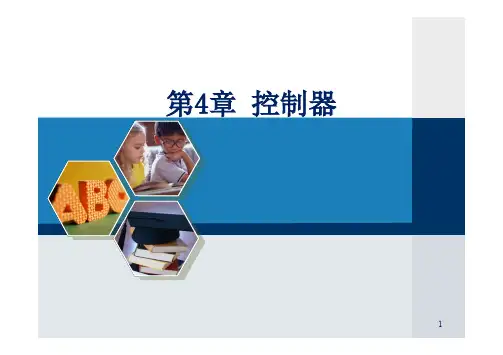
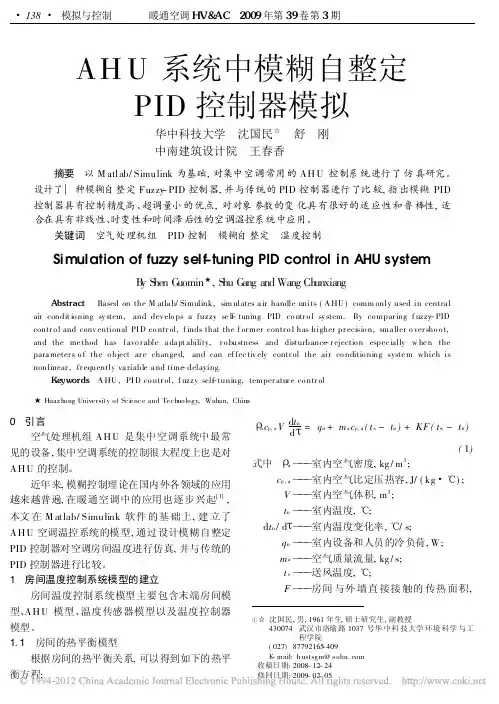
AH U系统中模糊自整定PID控制器模拟华中科技大学沈国民m舒刚中南建筑设计院王春香摘要以M atlab/Simulink为基础,对集中空调常用的AH U控制系统进行了仿真研究。
设计了一种模糊自整定Fuzzy-PID控制器,并与传统的PID控制器进行了比较,指出模糊PID 控制器具有控制精度高、超调量小的优点,对对象参数的变化具有很好的适应性和鲁棒性,适合在具有非线性、时变性和时间滞后性的空调温控系统中应用。
关键词空气处理机组PID控制模糊自整定温度控制Simulation of fuzzy sel-f tuning PID control in AHU systemB y S hen G uomin n,S hu G ang and Wang Ch unxiangAbstract Ba sed on the M atla b/Simulink,sim ulates a ir handle units(A HU)comm only used in centra l air condit io ning sy stem,and dev elo ps a fuzzy se lf-tuning PID co ntr o l sy stem.By co mpar ing f uzzy-PID contr o l and conv entional PI D co ntr ol,f inds that the f or mer contr o l has higher pr ecisio n,sma ller o ver sho o t, and the me thod has f avo r able a da pt ability,r o bustness and disturbance-r ejectio n espec ially w he n the para meter s o f the o bject ar e change d,and can ef fec tiv ely contr ol the air co nditio ning syste m which is nonlinear,fr equently va riable a nd time-delaying.Keywords A HU,PI D co ntr ol,f uzzy self-tuning,temper atur e co ntr oln Huaz hong University of Sci ence and Technology,Wuhan,China0引言空气处理机组AH U是集中空调系统中最常见的设备,集中空调系统的控制很大程度上也是对AH U的控制。
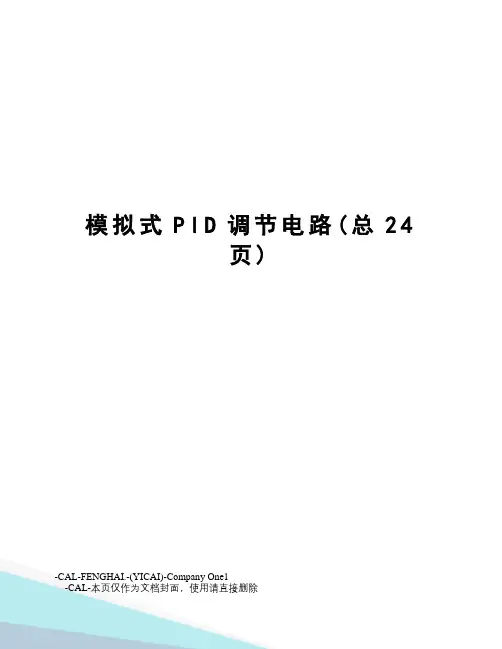
模拟式P I D调节电路(总24页)-CAL-FENGHAI.-(YICAI)-Company One1-CAL-本页仅作为文档封面,使用请直接删除湖南文理学院课程设计报告课程名称:电子技术课程设计院系:电气与信息工程学院专业班级:学生姓名:指导教师:完成时间:报告成绩:模拟式PID 调节电路的研究目录摘要........................................................................................................................................................................ ABSTRACT . (I)第一章模拟式PID调节电路结构 01.1基于PID调节规律的PID调节电路结构 01.2PID调节电路结构之比较 0第二章并联式模拟PID调节电路单元分析 (2)2.1PID调节电路单元的基石 (2)2.1.1 反相比例电路 (2)2.1.2 积分电路 (3)2.1.3 基本微分电路 (4)2.2调节单元电路分析 (5)2.2.1 比例调节(P调节) (5)2.2.2 比例积分调节(PI调节) (6)2.2.3 比例微分调节(PD调节) (7)2.2.4比例积分微分调节 (8)2.3数字式调节模式选择单元分析 (9)第三章基于MULTISIM10的模拟式PID调节电路的仿真 (10)3.1积分、微分电路的仿真 (10)3.1.1 积分电路的阶跃响应及频率特性 (10)3.2.2 微分电路的阶跃响应及频率特性 (11)3.2并联式模拟PID调节单元仿真 (11)3.2.1 数字式调节模式选择单元仿真 (11)3.2.2 P调节电路的阶跃响应 (12)3.2.3 PD调节电路的阶跃响应 (12)3.2.4 PI调节电路的阶跃响应 (12)3.2.5 PID调节电路的阶跃响应 (12)总结 (15)参考文献 (16)致谢 (17)附录1 并联式模拟PID调节仿真电路 (18)附录2 并联式模拟PID调节电路 (19)附录3 并联式模拟PID调节电路元件明细表 (20)PID调节规律是自动控制系统中常见而典型的控制策略,其中模拟式PID器是最基本的实现手段与方式。
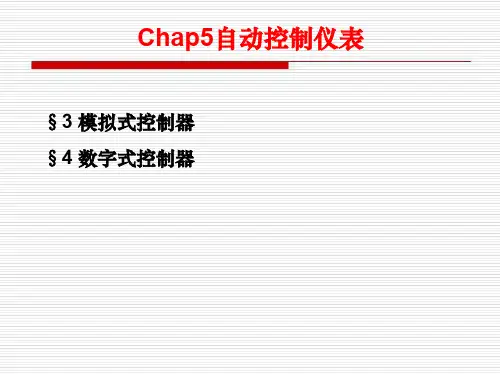
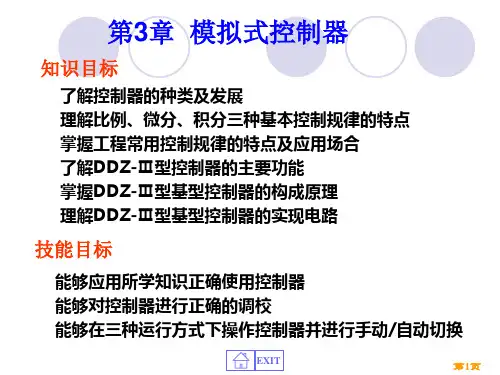
![GD系列模拟比例阀控制器接线及使用说明(V50)[1]](https://uimg.taocdn.com/90c03ae4b8f67c1cfad6b832.webp)
GD-PVAA-2430-11-Bx型电子放大器(电液比例控制器)欧式板,用于单电磁铁带阀芯位置反馈的比例阀GD-PVAA-2430-11-Bx型电液比例控制器用于控制4WRE10-10/24型带阀芯的直动式两位四通比例方向阀,根据误差信号的大小,提供相应电磁铁电流,位置。
放大器按照输入电压的变化成比例地控制阀芯位置,对电磁铁提供适量电非对称上升/下降斜坡发生器和PDF控制器,可对阀作出精确调整。
放大器在出厂前已与配用的比例阀进行了统调,具有优化而稳定的特性。
GD - PVA A - 24 30 - 11 - BVJGA-Atos 比例放大器11-1路输入1路输出B- 板式结构兼容出线A--模拟型21-2路输入1路输出M- 模块结构GD-力士乐D--数控型12-1路输入2路输出V- 输入电压控制兼容出线24-输入电压24V 22-2路输入2路输出I - 输入电流控制30-输出电流3A J- 军品15-输出电流1.5A1. 方框图2. 主要特性(硬件版本:V5.x)电源正极接2A(或2C)负极接4A(或4C)额定:24V DC 有前面板“电源”红色指示灯整流及滤波:V RMS =21-27V(最大脉冲峰值=2Vpp)供给电磁铁电流I MAX =3.3A,PWM型方波额定输入控制电压(工厂预调)GD-PVAA-2430-11-BV:支持±10V输入模式;GD-PVAA-2430-11-BI:支持4-20mA输入电流模式信号输入阻抗GD-PVAA-2430-11-BV:电压信号Ri>100KΩ;GD-PVAA-2430-11-BI:Ri=100Ω电位器供电相对于18AC,接点16AC供+10V/10mA,接点26A供-10V/-10mA输出电流使能信号向接点20A提供+9V ~ +24VDC,使能功率输出电路,接点20A悬空或接信号地,禁止功率输出,前面板“故障”红色指示灯复用斜坡供电0.02-5S;需要提供使能信号(短路8A和28A)断线/短路保护指示前面板“故障”红色指示灯,指示位移传感器断路,或电磁铁负载短路,或无使能信号插板格式欧式100X160mm(见DIN41494标准中的插板单元)配用连接支架型号为GD-PVAB-1,匹配有DIN41612/D凸头及接线端子位移传感器驱动信号频率 2.5kHz工作温度0~40℃(军品-40~60℃)3. 一般技术条件3.1. 电源要求电液比例控制器使用24V直流供电。
湖南文理学院课程设计报告课程名称:电子技术课程设计院系:电气与信息工程学院专业班级:学生姓名:指导教师:完成时间:2011.6.23报告成绩:模拟式PID 调节电路的研究目录摘要 (I)ABSTRACT ......................................................................................................................................................... I I 第一章模拟式PID调节电路结构 (1)1.1基于PID调节规律的PID调节电路结构 (1)1.2PID调节电路结构之比较 (1)第二章并联式模拟PID调节电路单元分析 (2)2.1PID调节电路单元的基石 (2)2.1.1 反相比例电路 (2)2.1.2 积分电路 (3)2.1.3 基本微分电路 (3)2.2调节单元电路分析 (5)2.2.1 比例调节(P调节) (5)2.2.2 比例积分调节(PI调节) (5)2.2.3 比例微分调节(PD调节) (6)2.2.4比例积分微分调节 (7)2.3数字式调节模式选择单元分析 (8)第三章基于MULTISIM10的模拟式PID调节电路的仿真 (9)3.1积分、微分电路的仿真 (9)3.1.1 积分电路的阶跃响应及频率特性 (9)3.2.2 微分电路的阶跃响应及频率特性 (10)3.2并联式模拟PID调节单元仿真 (10)3.2.1 数字式调节模式选择单元仿真 (10)3.2.2 P调节电路的阶跃响应 (11)3.2.3 PD调节电路的阶跃响应 (11)3.2.4 PI调节电路的阶跃响应 (11)3.2.5 PID调节电路的阶跃响应 (11)总结 (14)参考文献 (15)致谢 (16)附录1 并联式模拟PID调节仿真电路 (17)附录2 并联式模拟PID调节电路 (18)附录3 并联式模拟PID调节电路元件明细表 (19)PID调节规律是自动控制系统中常见而典型的控制策略,其中模拟式PID器是最基本的实现手段与方式。
TC-8900全合1控制单元和ES-8930遥控设定模块简介TC-8900是模拟式控制器家族,用于二管式,二管转换型,二管式带电盘管或四管式风机盘管装置。
这一家族包括全合1控制器单元(TC8900)、遥控设定模块(ES-8930)和内置式控制器单元(TC-8930)TC-8900易于使用,它集大部分常用室内空调的功能为一身。
特点及效益-全合1紧凑包装:传感器,正/反向输入,窗口输入, 用最小包装实现最大效益PI控制,2个阀门输出,模式(舒适/后备)按钮,设定值调节器.-有限制设定值调节范围或取消设定值调节 在各种环境下皆可使用-主动或被动输入 输入方式灵活:温度,湿度,差压等 -现代型及考虑周全的面板嵌合在插入式安装底盒上 与室内装修相协调,易于安装。
-电气端子位于安装底盒上 易于接线及调试-安装配件的范围是标准的 安装灵活订货参数输出传感器输入*全合1控制器单元TC-8903-1131-WK 1xPAT 内置 NTCTC-8901-2131-WK 2x0…10V 内置NTCTC-8904-2131-WK 2xDAT 内置 NTCTC-8906-2131-WK 2xOn/Off 内置NTCTC-8903-1132-WK 1xPAT 遥置 NTCTC-8901-2132-WK 2x0…10V 遥置 NTCTC-8904-2132-WK 2xDAT 遥置 NTCTC-8906-2132-WK 2xOn/Off 遥置 NTC设定范围:12~28度输出传感器输入全合1控制器单元TC-8903-1151-WK 1xPAT 内置NTCTC-8903-1152-WK 1xPAT 遥置 NTC设定范围:0~40度输出传感器输入全合1控制器单元TC-8903-1183-WK 1xPAT 遥置0 (10V)TC-8901-2183-WK 2x0…10V 遥置0 (10V)设定范围:0~100%*遥置传感器输入:见本文件最后一页“技术规格”输出传感器输入内置控制器单元TC-8933-1112-W 1xPAT 从 ESTC-8931-2112-W 2x0…10V 从 ESTC-8934-2112-W 2xDAT 从 ESTC-8936-2112-W 2xOn/Off 从 ES*设定范围:遥控,见ES-8900遥控设定模块输出传感器输入*ES-8930-3031-WK --内置 NTC*设定范围:12~28摄氏度附件附件(分开定购)定购号 说明TM-9100-8900 传感器盒的开启工具TM-9100-8901 拨盘停止螺钉组(100只一包装的自攻螺钉)TM-9100-8931-W 塑料表面安装组件TM-9100-8941-W 墙装组件TM-9100-8951-W 面板安装组件附件详情见“RS-9100”产品手册技术特点-带NTC传感器输入的模块型号TC-8901 系列TC-8903 系列TC-8904 系列TC-8906 系列无控制作用带0 to 2 K - 0 to 2 K 0 to 2 K 差额- - - 0.2 to 2 K比例带1…4 K 2…8 K 1…4 K -分钟- 时间- 120 秒 5 (15)积分时间- 关闭或 4 分钟- - 备用偏差 BSB 2 K 2 K 2 K 2 K窗口偏差 BOF 5 K 5 K 5 K 5 K技术特点-带0-10V传感器输入的模块型号TC-8901-2183-WK TC-8903-1183-WK无控制作用带0 to 10% -比例带 5 to 20% 10 to 40%积分时间- 关闭或 4 分钟备用偏差 BSB 10% 10%窗口偏差 BOF 25% 25%应用TC-89x0控制器既可安装在墙上也可安装于风扇盘管之中,接收从遥置设定模块所发出的设定信息。
A PLC概述许多不同的过程控制系统的自动化,如控制生产机械或工厂生产线,由被称为可编程逻辑控制器(PLC)的小型计算机完成。
1968年,通用汽车公司首创PLC并应用于汽车工业,并开发第一个PLC工程,用电子控制器替代硬接线的继电器系统。
随着PLC的出现,工厂过程控制的集中化,尤其在汽车工业中,得到了大幅提高。
PLC 的架构PLC是一个无盘的紧凑计算机,包含所有过程控制必需的软硬件。
他们通常用于自动化控制应用(如闭环控制),可以独立存在,也可以连到分布I/O,其他PLC或者监控计算机。
这些连接通过现场总线建立,如WorldFIP, PROFIBUS 或者Ethernet.典型的PLC包含:▪电源▪程序运行的CPU▪输入输出模块▪可选通信模块可用IO模块支持很多电气接口:▪模拟模块(+/- 10V, +/- 1V, 4-20ma, 电阻,等)▪温度测量(pt100, Ni 100, 等).▪数字模块(+/- 24V, 220V, 等.)▪TTL 模块(Beckhoff I/O 模块, 等.)▪RS 232 模块▪其他这些模块可以连接到PLC的内部总线上,也可以通过总线连接器和现场总线单元(如PROFIBUS, WorldFIP or CAN)连接,并于其他PLC共享总线。
用户的硬件很难和PLC内部总线直接连接。
解决的方案是使用特定接口卡(如HMS的AnyBus 卡)作为标准现场总线接口(如PROFIBUS, CAN, and WorldFIP)集成用户硬件。
现在,PLC提供基于以太网的通信。
尽管基于TCP/IP 和IEEE 802.2,每个厂商的PLC协议都不同。
因此,默认情况下,不同厂商的PLC不能通过以太网交换数据。
但是,施耐德的的PLC拥有接口库,可以用西门子PLC实现RFC1000,也可以使用OPC DX服务器,SCADA应用,或者特定通信接口卡,如APPLICOM one,作为网关。
基于PLC的方案可以很好用于两层控制体系架构中,前端层独立于监控层。